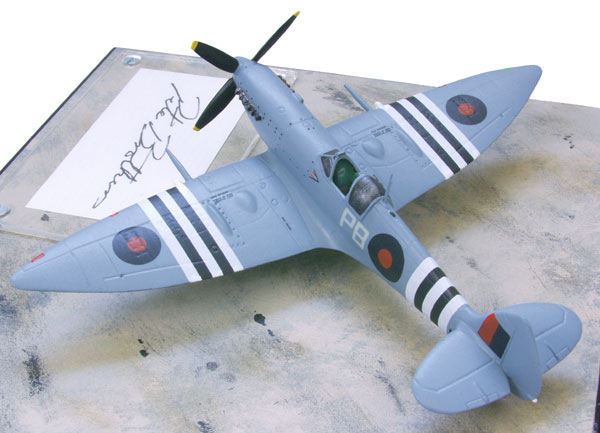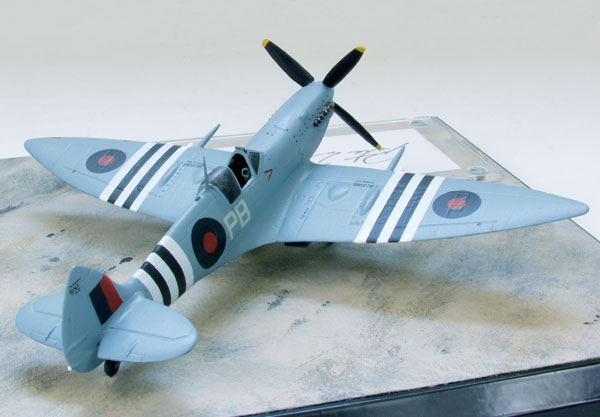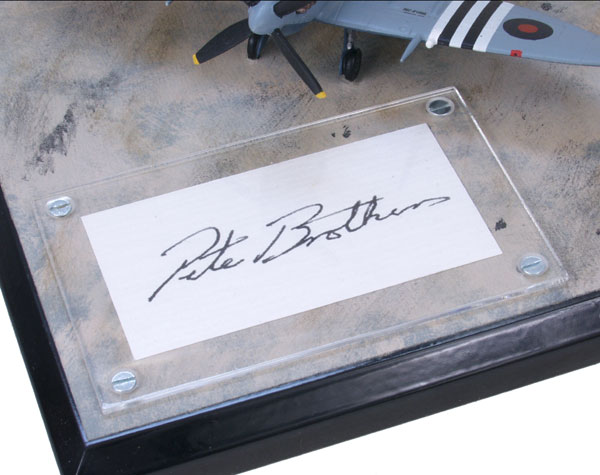Supermarine Spitfire HF Mk VII
Supermarine Spitfire HF Mk VII PB MD188
Culmhead Wing, Wg Cdr Pete Brothers, D-Day 6th June 1944.
It was not just the airframe of the Spitfire which continued to be developed; its power plant, the legendary Rolls Royce Merlin, was also evolving. The 60 series engines were fitted with a two-stage, two-speed supercharger and intercooler. Whilst this resulted in an engine capable of operating at higher altitudes, it also increased the size of the unit. As a consequence, when mated to the Spitfire airframe, the nose of the aircraft was extended to accommodate it. The potential of a high altitude fighter was soon realised and so the Spitfire Mk VII was born. The aircraft was fitted with a pressurised cockpit, and extended wingtips and rudder to aid performance at its maximum altitude of 45,700 feet. Additional fuel tanks were fitted into the leading edge of the wings, the aircraft carrying the ‘C’ type wing armament of two 20mm Hispano cannon (120 rounds per gun) and four 0.303in Browning machine guns (350 rounds per gun).
MD188 was one of the last of the 140 Spitfire Mk VII’s to be built. It was first flown on the 21st of May 1944 and issued to 131 Squadron in June, before being adopted by the Culmhead Station Flight and wasr piloted by Wing Commander Pete Brothers.
Painted with narrow invasion stripes on upper and lower surfaces of the wings and fuselage for D-Day identification purposes, the Spitfire Mk VII’s provided invaluable high altitude ‘top’ cover defending other aircraft during the invasion of Europe. Later in the war many Spitfire Mk VII’s were fitted with standard wing tips and used in more conventional fighter roles.
Pete Brothers had flown Hurricanes at the beginning of the war during the Battle of France and again in the Battle of Britain. By the end of the war he had a tally of 16 aircraft destroyed, 1 probably destroyed and 3 damaged. His last victory was achieved on the 7th of August 1944 flying MD188 when he shot down an Fw 190 over France.
PETER MALAM BROTHERS 37668
Pete Brothers was born in Prestwich, Lancashire on September the 30th 1917 and educated at North Manchester School. He learned to fly at 16 and joined the RAF on a short service commission in January 1936. He was posted to 9 FTS, Thornaby on April 4th and joined 32 Squadron at Biggin Hill on October 11th 1936, becoming a Flight Commander in late 1938.
Still with the squadron in 1940, Brothers claimed a Bf 109 on May 18th, a Bf 110 on the 23rd, Bf 109s on July 19th, 20th and 29th, a Bf 110 on August 16th, a Bf 109 and a Do 17 on the 18th and Bf 109s on the 22nd and 24th.
Brothers was posted to 257 Squadron at Debden on September 9th, as a Flight Commander, and on the 15th he destroyed a Do 17 and a Ju 88. He was awarded the DFC (13.9.40) and posted to 52 OTU in January 1941 as an instructor.
Brothers was posted to Baginton in June 1941 to form 457 (RAAF) Squadron, with Australian pilots and RAF ground crews. On March 26th 1942 he claimed a Bf 109 destroyed and on April 29th a probable FW 190. He took command of 602 Squadron at Redhill in June 1942 and on the 26th he damaged two FW 190s, on August 18th destroyed a FW 190 and on the 19th damaged another.
In October 1942 Brothers was appointed Wing Leader at Tangmere. He destroyed a FW 190 on January 26th 1943 and was awarded a Bar to the DFC (15.6.43). On July 29th Brothers was posted to 61 OTU and moved to a staff job at HQ 10 Group on November 22nd. He destroyed a FW 190 on January 12th 1944.
A return to operations came in April 1944, when Brothers was appointed Wing Leader at Exeter. There were six squadrons in the Wing, scattered over various airfields and difficult to control. Brothers split the Wing into two. He continued as Culmhead Wing Leader and Wing Commander H A C Bird-Wilson took over the Harrowbeer Wing. On August 7th Brothers destroyed a FW 190. In October 1944 he was posted away and awarded the DSO (3.11.44).
Brothers went to Fort Leavenworth, Kansas for a course at the Command and General Staff School. After returning to Britain he was posted to the Central Fighter Establishment, where he stayed until leaving the RAF in March 1947. In September 1945 Brothers took part in the first Battle of Britain flypast over London, led by Douglas Bader.
He joined the Colonial Service and served in Kenya, where he flew his own aircraft. Brothers rejoined the RAF in 1949, was posted to Bomber Command and given command of 57 Squadron. He took it to Singapore on March 15th 1950, the first bomber squadron to participate in the Malayan campaign, and returned to Britain on July 11th.
A long and distinguished career in the RAF followed, ending with Brothers retirement on April 4th 1973, as an Air Commodore. He was made a CBE in 1964.
APO 23.3.36 PO 27.1.37 FO 27.10.38 FL 3.9.40 SL 1.12.41 WC 1.7.45 SL 5.8.46 WC 1.1.53 GC 1.1.59 AC 1.7.66
Ref: Men of the Battle of Britain by Kenneth G. Wynn (CCB Publications)
Scale 1:72 Wingspan 6.7″ (170 mm)
Base size 6.37″ (162 mm) square (No. 5)
Weight not including base 6.75 ozs (190 grams)
Limited edition of 60 only
Total number of models produced 60




